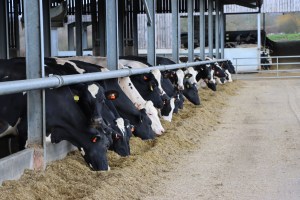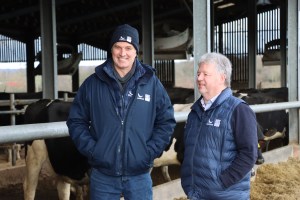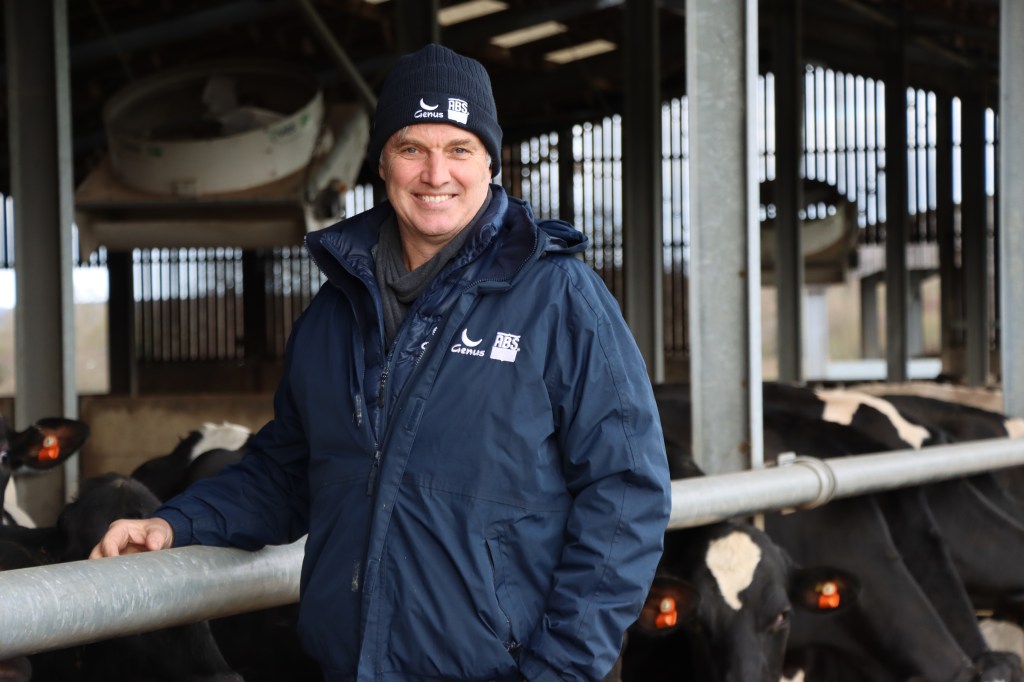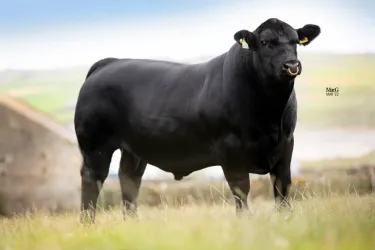The renowned Curtismill herd, managed by the Torrance family, has been producing almost 14,000 litres of milk annually since implementing a herd improvement package four years ago.
Eager to accelerate the genetic progress of their herd, Curtismill Holsteins, based in Essex, joined GENEadvance® as part of Genus ABS’ original trial herds. As part of the package, every animal in their 700-cow herd is genomic tested so they can evaluate the true genetic merit of each individual animal.
Doing this allows for careful selection when breeding to beef or dairy, with the aim to breed their best cows and heifers to sexed dairy genetics, and the rest to beef.
John Torrance, who farms alongside his parents and wife, Lucy, seeks to improve the production of his herd by 5% annually through more accurate breeding decisions and the use of elite genetics.
The benefits of using a herd improvement programme
Since using GENEadvance®, Curtismill Holsteins have received customised breeding plans and support from Genetic Services Specialists to help guide them on interpreting the genomic data, ranking their herd and creating a breeding plan aligned with their personal goals.
When asked about GENEadvance®, John explained: “The customised breeding plan is really helpful because it’s confusing when you have big cow numbers. The expertise and support is one of Genus ABS’ big pluses.”
Over the years, the Torrance family has worked closely with their Breeding Advisor, Colin Platten, and Genetic Services Specialist, David Guthrie, to formulate the optimum breeding strategy.
Following the plan closely, the herd has seen 99% improvement in £PLI since starting on GENEadvance, marking the herd in 15th place in AHDB’s top £PLI herd rankings. The advancement of the herd can also be seen in their heifers who are now ranking in 11th place in the top Holstein genomic heifer herds (AHDB.)
To be in the top 1% of Holstein youngstock, animals need to have a £PLI of over £500 (AHDB). Of the calves born into John’s herd in 2023, 93% of them placed in that top 1% bracket.
Their goal of producing more milk is also proving to be a success with 53.6% of their youngstock landing themselves in the top 1% for milk production (requires +534kg.)
Genomic testing the Curtismill herd
Genomic testing has since become a part of John’s routine on farm. Leading the process himself, he takes samples from 60 calves at a time. Once the results are back, he moves onto sampling a further 60, and operates in this cycle.
Using GENEadvance® has allowed Curtismill Holsteins to accurately assess the performance and potential of every animal in the herd. This means they can be very selective with which animals they breed from. Doing this will boost their genetic progress and overall profits from both production and beef.
Their latest genetic review, which demonstrates the progress they are making in the herd, showed that the oldest animals, in their fourth lactation, average just over £200 PLI. Their youngest animals are now averaging £600 PLI, with their last two groups of results averaging over £630. There has been a very clear step change in their genetic progress trajectory since the implementation of GENEadvance®.

Operating a sexed and beef strategy
By breeding his best performing animals to sexed semen, John can ensure the offspring will see genetic improvement when bred to an elite bull. Exclusively using Sexcel®, they have no concerns over fertility and prioritise milk production for their Muller Tesco contract, which requires 4% fat.
Animals that are bred to sexed genetics see a conception rate of over 40% and pregnancy rate over 29%. Prior to using GENEadvance® and sexed genetics, the herd had a pregnancy rate of just 18%. John says the improvement has been down to the genetics they use and their use of herd monitoring technology.
Using Sexcel®, John uses 2.1 straws per service and sees an average of 3% male calves, giving them a 97% success rate in breeding females.
John says you can definitely see the genetic progress in his heifers and added: “The heifers sit flat. Production wise, we’ve never had milk like we’ve had in this last two months!”
With a desire for a more efficient herd, John wants to breed animals with a small frame, rather than the classic ‘show-type’ cow. He explained: “We want them as small as we can get away with and still produce the same milk. I’ve got no issues with small cows, I love them. I want ghosts.”
The idea of having ‘ghosts’, or ‘invisible cows’, describes the desire for easy-to-manage animals which require little vet intervention, reduced feed and have an easy temperament.
“They’re no trouble, no maintenance, just easy and produce over 70 tonnes.”
Breeding to reduce the size of his animals, the herd now has 842 animals which rank negative for maintenance. This reduction in size and maintenance has saved the farm thousands of pounds in feed costs.
When selecting which bulls to breed from, John likes to stick to those with high £PLI. He added: “By going down the £PLI route, we have really reduced our calving interval massively since 2018 and that’s through the bulls we’re using.”
As part of their criteria, John will only select sires with over 700kg milk production, to maximise the potential of his animals.
Since being more selective with his breeding, 30% of the herd go to sexed genetics and 70% to beef. Curtismill Holsteins joined the Warrendale Wagyu scheme 13 months ago to guarantee the best outcome.
Previously, the farm used Aberdeen Angus genetics but moved over to Warrendale Wagyu to further increase their profits. Impressed by the performance of their Wagyu beef animals, John said: “They calve easier and have worked really well.”
Beef calves are kept for two to four weeks on Curtismill Holsteins and are then collected and placed on a rearing farm.

Making steps to improving cow comfort
Due to East Anglia being an arable area with poor grass growth, cows are typically housed inside. The Torrance family have made extensive efforts in cow comfort and have invested a lot of money in new sheds, including a new 320-cow building which was built 10 years ago and matched again in 2018.
John said they made this investment to give their cows the space to unleash their genetic potential. When moving from their old shed, to the new state-of-the-art facility, their production increased by 2000 litres ‘overnight.’ John puts this down to the cows having more space and therefore being more comfortable.
To take cow comfort to the next level, they provide sand beds for all of their animals. John explained: “Sand has revolutionised everything, including mastitis. We still get some cases of mastitis, but nothing like what we were. We’re less than six cases per 100 cows now and we haven’t treated a cow with antibiotics due to mastitis since 2018.”
Planning for the future of the curtismill herd
With cow numbers hitting 700 with 600 followers, the Torrance family aim to maintain the size of their herd and are prioritising production. Currently, they are seeing 13,700 litres of milk sold but are aiming to hit the 14,000 mark in just a couple of months. Since just December 2023, milk production at Curtismill Holsteins has increased by 7,000 litres per day at 47 litres per cow.
Using GENEadvance® and working with Genus ABS’ Genetic Services Specialists will aid them along their journey to maximising milk production.
When asked if John would recommend GENEadvance® to a friend or fellow farmer, he said: “Yes, if they’re going to use it for the right reasons. It’s got to be used as a management tool, there’s no point doing it and not using the data!”
The data that comes with the package is really the key to accelerating your herd’s genetic progress, gaining you insight you can’t see with just your eyes.
Interested in implementing your own herd improvement programme? Get in touch with your breeding advisor today and ask about GENEadvance®, or fill out the form below.






